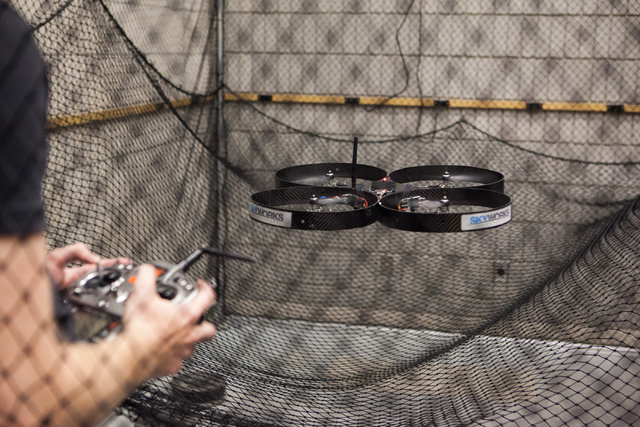Another attraction in Nevada for drones — the great indoors
When the Federal Aviation Administration considered Nevada as a site for unmanned aerial vehicle tests last year, regulators were impressed with the state’s wide-open spaces.
With airspace miles from any building, the state offered locations safely away from any asset that could be damaged by a drone gone awry.
Little did anyone know at the time that Nevada’s vast wide-open indoor spaces could also be an asset.
Representatives of a division of the governor’s economic development office have begun making contact with the operators of convention centers in Southern Nevada in an effort to develop a network of indoor test ranges.
The idea is to provide small unmanned vehicles a place to fly in venues that are between conventions and trade shows.
James Fleitz, a vice president for a subsidiary of Bowhead, the contractor working with the state’s unmanned aircraft systems program management office, gave a progress report at a recent Nevada Institute of Autonomous Systems board meeting. He told board members that initial contacts with hotel executives have been positive.
“The people we’ve been talking to are really interested in this,” Fleitz said. “We have more convention centers than any other city,” he said. “Some of them have high capacity, but because Las Vegas is such a convention mecca and we have multiple locations, we could offer some range time if we string them all together.”
Fleitz won’t say which properties he’s approached, but said one of them was willing to conduct a test flight just to see if it would work. It did.
Las Vegas Convention Center representatives say they haven’t been contacted about being part of the network.
LOOKING TOWARD SMALL VEHICLES
Indoor drone flights would be suitable only for the smallest of vehicles, Fleitz said. Unmanned aerial vehicles are categorized by weight and the two lightest classifications — up to 12 pounds and up to 55 pounds — would work best indoors. He added that helicopter-type vehicles would be more suitable indoors than small fixed-wing aircraft.
Experts believe small vehicles will represent 80 percent of the commercial drone industry.
As of June 30, the economic development office had reached out to about 100 of 300 companies nationwide involved in unmanned aerial systems. Steve Hill, the office’s executive director, said about 30 of those companies have shown interest in moving to the state.
But Fleitz believes the indoor range concept could increase those numbers.
“If you’re trying to develop an unmanned aerial system for commercial industry, you have to secure a certificate of authorization from the Federal Aviation Administration,” Fleitz said. “Developers must prove that their assets are airworthy and well-manufactured. It’s a process that can take two to six months.”
Fleitz said not every vehicle is ready for an FAA operation certificate — but they’re close.
Those are the types of vehicles that could use an indoor range to fine-tune vehicle operations before they’re certified to fly at one of Nevada’s four outdoor test sites. Also, indoor air space isn’t under the FAA’s jurisdiction.
There are several advantages to conducting test flights indoors.
“It’s a controlled environment,” Fleitz said. “Sometimes, there are variables outdoors, like wind, that can affect a test. Indoors, we can control that.”
Some of the data the Federal Aviation Administration is seeking from tests is whether vehicles are flying where their instruments say they are flying.
The earliest tests at Nevada’s four outdoor sites — Reno-Stead Airport, Boulder City Municipal Airport, the Naval Air Station at Fallon and the Energy Department-operated Desert Rock Airport on the Nevada National Security Site — would be flights within view of pilot on the ground.
The initial flights will let operators visually confirm the test data. If the instruments say a vehicle is 10 feet off the ground, pilots would be able to confirm it.
Indoor flight variables could be changed by adding one fan, or several, to simulate outdoor conditions.
RESOLVING THE PRIVACY ISSUE
Indoor flights also resolve privacy problems.
The Autonomous Systems board is developing a privacy plan, to address the public’s concerns about vehicles flying near their neighborhoods and to keep rival companies from accessing test data.
“You can literally shut the doors and lock people out and restrict how the asset is used,” Fleitz said.
Most convention centers already have the features unmanned systems need — such as a communications network.
“Most of them have a Wi-Fi network that works in all corners of the building,” Fleitz said. “That would help a number of these systems that rely on an Internet connection to transmit data.”
Because convention centers are connected to hotels, it would be easy to schedule tests in secure locations with minimal travel. Fleitz envisions companies being able to book a bank of rooms for engineers and scientists to watch tests without ever having to leave the building.
Because the concept is so new, it’s too early for hotel companies to develop a price list to use a convention hall for an indoor test range.
Indoor tests have advantages.
Some of the buildings have metallic ceilings or roofs that could limit the communications capabilities between a pilot and a vehicle.
Ceiling heights also would limit flight elevations.
Fleitz believes the idea of the state providing indoor test ranges has limitless potential.
“We’re trying to simulate conditions for flights that can’t be done with onboard pilots,” he said. “We’ve talked with companies that have ideas for exploring mine shafts with small vehicles. In an indoor environment, you could set up obstacles to simulate a mine and test the maneuvering capabilities and communications links. Someday, maybe a company with a convention hall would build a wind tunnel so that we could test vehicles in a high-wind environment.
“There are lots of possibilities.”
Contact reporter Richard N. Velotta at rvelotta@reviewjournal.com or 702-477-3893. Follow him on Twitter @RickVelotta.






















